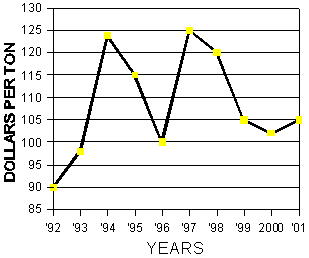Alfalfa Report
Yuma County, Arizona
March 12, 2001
Yuma County Office
2200 W. 28th Street, Ste. 102
Yuma, AZ 85364
(520) 726-3904
(520) 726-8472 FAX
Production Update:
PDF version, 16KB
Hay Drying Agents: Hay drying agents can decrease hay drying time by one to two days. Decreased drying time can prevent loss of yield and nutrients due to exposure, lessen wheel traffic damage since regrowth is shorter, decrease damage by shading from windrows, and potentially increase yield of the next cutting if irrigation is not delayed. Drying agents disrupt the waxy layer on the stem allowing faster drying of cut alfalfa. Hay drying agents are most commonly applied to alfalfa with sprayers attached to the mower-conditioner at the time of cutting.
Insect Management: Insect management in alfalfa depends on a good monitoring program. Management decisions should be based on suitable sampling methods to estimate insect pests populations. Check fields at least once a week and more often when counts show that a pest population is approaching damaging levels. Correct identification of insect pests and their damage is essential. Several factors need to be considered when sampling insect populations. Time of day can greatly influence the reliability sampling methods. Nocturnal pests hide during the day. Morning dew or strong winds can alter counts of some insects. Sample at several sites in each field quadrant. Choose sampling methods that are reliable for the insect pests being monitored. Avoid field edges for general sampling, but observe field edges for invading insects. Contact your local Cooperative Extension office for information on alfalfa insect pests, sampling procedures, and control measures.
Weed Control: Reminder: Weed control product update meetings
- March 20th at the Shilo Inn, Yuma, (8:00 am to 11:30 am); March 21st
at the Blue Water Resort, Parker, (7:00 - 10:30 am), and on March 21st
at the Casa Serreno Restaurant, Mohave Valley, (12:00 to 3:30 pm).
| Market Summary |
High
|
Low
|
Average
|
Off grade
|
| Past 2 Weeks (Feb. 26 to Mar. 11, 2001 2001) |
115
|
100
|
105
|
70-95
|
| Last Year ( Feb. 26 to Mar. 11, 20012000) |
105
|
90
|
102
|
70-100
|
10 Year Summary (February 26, to March 11, 1992-2001):

Issued in furtherance of Cooperative Extension work, acts of May 8 and June 30, 1914, in cooperation with the U.S. Department of Agriculture, James A. Christenson, Director Cooperative Extension, College of Agriculture and Life Sciences, The University of Arizona.
The University of Arizona is an equal opportunity, affirmative action institution. The University does not discriminate on the basis of race, color, religion, sex, national origin, age, disability, veteran status, or sexual orientation in its programs and activities.
Any products, services, or organizations that are
mentioned, shown, or indirectly implied in this web document do not imply
endorsement by The University of Arizona.
Information provided by:
Barry Tickes, btickes@ag.arizona.edu Extension Agent, Yuma County
Michael Ottman, mottman@ag.arizona.edu Agronomy Specialist
College of Agriculture, The University of Arizona.
Eric Natwick, etnatwick@ucdavis.edu UCCE Imperial County - Farm Advisor
University of California, Davis, CA.
Material written March 12, 2001.
Forages: Crop Mgmt | Soil Mgmt | Irrigation | Alfalfa Reports | Insects | Diseases | Weeds | Pesticides
Home | Other Crops | Forages
For more Arizona Production Ag Information:
Home | Cotton | Veggies| Forages | Grains | Citrus | Crop x Crop | Insects | Diseases| Weeds | Pesticides | News | Weather | Research | Photos | Contacts | General Info. | Site Map
Copyright © 2001 University of Arizona,
College of Agriculture and Life Sciences
Webmaster: Al Fournier (fournier@ag.arizona.edu)